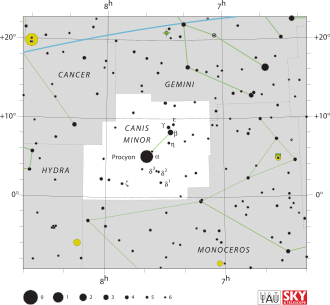Canis Minor: Difference between revisions
No edit summary |
No edit summary |
||
| (3 intermediate revisions by 2 users not shown) | |||
| Line 12: | Line 12: | ||
==== Greco-Roman ==== |
==== Greco-Roman ==== |
||
===== |
===== Aratus ===== |
||
<blockquote>But yet another constellation sweeps across the horizon: they call it the Hydra. Like a living thing [445] it winds at great length, its head comes below the middle of the Crab, its coil under the Lion’s body, and its tail hangs over the Centaur himself. On its middle coil lies the Bowl, and on the last one the figure of a Raven that looks like one pecking the coil. [450] Yes, and there too Procyon shines brightly beneath the Twins. (Kidd 1997)</blockquote> |
|||
===== Eratosthenes ===== |
===== Eratosthenes ===== |
||
===== Hipparchus ===== |
===== Hipparchus ===== |
||
===== Hyginus, Astronomica ===== |
|||
<blockquote>Procyon seems to rise before the greater Dog; for this reason it is called the Fore-dog. By some it is thought to be Orion's dog, and it is put in all the same tales in which the greater Dog is numbered. (Mary Ward 1960)</blockquote> |
|||
===== Geminos ===== |
===== Geminos ===== |
||
| Line 58: | Line 62: | ||
|} |
|} |
||
===Transfer and Transformation of the Constellation=== |
===Transfer and Transformation of the Constellation=== |
||
<gallery> |
|||
File:Ori+cma+cmi kugel.jpg|Canis Minor on the Kugel Globe (1st c. BCE), drawing by SMH 2021 |
|||
File:Canis Minor Uranometria.jpg|Canis Minor in Bayer's Uranometria (1603) |
|||
File:Johannes Hevelius - Prodromus Astronomia - Volume III "Firmamentum Sobiescianum, sive uranographia" - Tavola SS - Canis Minor.jpg|Canis MInor in Hevelius (1690) |
|||
File:John Flamsteed - Gemini and Canis Minor.jpg|Canis Minor with Gemini in Flamsteed (1728) |
|||
File:CMi bode.jpg|Canis Minor in Bode (1782/1805) |
|||
File:1822 - Alexander Jamieson - Monocerus, Canis Minor, Canis Major.jpg|Canis Minor in Jamieson (1822) |
|||
File:Sidney Hall - Urania's Mirror - Monoceros, Canis Minor, and Atelier Typographique.jpg|Canis Minor in Hall (1825) |
|||
</gallery> |
|||
==Mythology== |
==Mythology== |
||
Latest revision as of 04:04, 3 May 2025
One of the 88 IAU constellations. In antiquity, this area was named "pro kyon", "the one [star] before the dog". The name ‘Little Dog’ for the constellation is first documented by Ptolemy; however, Eratosthenes already mentions a group of three stars, which is the Hound of Orion. In the Almagest, two stars are listed for this constellation. This can therefore never have been descriptive, but was merely a name.
Etymology and History
Aratos, Eratosthenes, Hipparchus and other Greek astronomers call the constellation Procyon, the name we ascribe to the brightest star today. The star Procyon therefore has one of the few original Greek names: ‘pro’ means ‘before’ and ‘kyos’ is the dog. The Procyon is therefore the ‘pre-dog’ or ‘the star that rises before the dog’, as Eratosthenes unimaginatively explains. Ptolemy calls the single star Sirius ‘the dog’ and therefore only a single bright star is the ‘pre-dog’. Just as the Egyptian word ‘Sothis’ for a group of three stars was later reduced to a single star (Sirius), the Greek word ‘Procyon’ suffered the same fate.
The bright star Procyon was possibly used in Mesopotamia as an indicator for the rising of Cancer. The stars in Cancer are so faint that you can barely see them at dusk - but the bright Procyon rises at the same time, which is suitable for telling the time.
Origin of Constellation
Greco-Roman
Aratus
But yet another constellation sweeps across the horizon: they call it the Hydra. Like a living thing [445] it winds at great length, its head comes below the middle of the Crab, its coil under the Lion’s body, and its tail hangs over the Centaur himself. On its middle coil lies the Bowl, and on the last one the figure of a Raven that looks like one pecking the coil. [450] Yes, and there too Procyon shines brightly beneath the Twins. (Kidd 1997)
Eratosthenes
Hipparchus
Hyginus, Astronomica
Procyon seems to rise before the greater Dog; for this reason it is called the Fore-dog. By some it is thought to be Orion's dog, and it is put in all the same tales in which the greater Dog is numbered. (Mary Ward 1960)
Geminos
Ancient Globes
The Lesser Dog is only depicted on the Kugel Globe; it is absent on the Farnese Globe and the Mainz Globe.
Almagest Προκύων
| id | Greek
(Heiberg 1898) |
English
(Toomer 1984) |
ident. |
|---|---|---|---|
| Πρόκυνος ἀστερισμός. | |||
| 1 | ὁ ἐν τῷ αὐχένι | The star in the neck | |
| 2 | ὁ κατὰ τῶν ὀπισθίωυ λαμπρὸς καλούμενος Προκύωυ. | The bright star just over the hindquarters, called Procyon | |
| all | ἀστέρες β, ὧν α μεγέθους α, δ’ ἄ. | {2 Stars, 1 of the lirst magnitude, 1 of the fourth} |
Transfer and Transformation of the Constellation
Mythology
It was the Roman mythographer Hyginus who first handed down a legend about this constellation: if this dog was the dog of Ikarios - which Eratosthenes describes as one of the legends of the Great Dog - then this dog committed suicide when his master was murdered: the wine produced in ancient Greece was very strong and would probably be difficult for us to drink today. It wasn't easy to drink back then either. Ikarios is considered to be the one who introduced winemaking to Athens and it is said that he was murdered by some customers while intoxicated. His dog reported the crime by barking, but when he realised that his master could not be saved, he himself no longer wanted to live.













